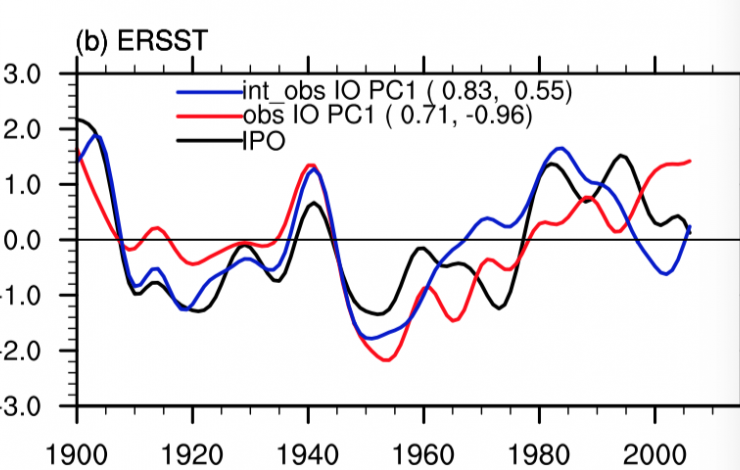
Time series of the Inter-decadal Pacific Oscillation (IPO, black lines), the decadal Indian Ocean Basin mode (IOB, red lines), and internal component of the decadal IOB mode with external forcing (obtained from ensemble mean of three all forcing runs based on CESM1.2) removed (blue lines) from ERSST. All the time series are standardized. The correlation coefficients with the IPO during 1900–2012 and 1985–2012, respectively, are shown in parentheses.
Dong, L., and M.J. McPhaden (2017): Why has the relationship between Indian and Pacific Ocean decadal variability changed in recent decades? J. Climate, 30(6), 1971–1983, doi: 10.1175/JCLI-D-16-0313.1.
Lu Dong and Michael McPhaden's recently published paper in the Journal of Climate is featured as a Research Highlight by Nature Climate Change on April 5, 2017. The paper analyzes why the relationship between the decadal Indian Ocean Basin (IOB) mode and Interdecadal Pacific Oscillation (IPO) has changed in recent decades. “Historically, patterns of decadal sea-surface temperature (SST) variability in the Indian and Pacific Oceans have been strongly connected. This is because warm anomalies in the Pacific Ocean (positive phase of the IPO) force warmth in the Indian Ocean (positive phase of the IOB) through coupled air–sea interactions. However, since 1985, this relationship has broken down, the cause of which is not well understood.
The paper investigates the factors causing this change using observations and coupled climate model simulations. They find that greenhouse gas forcing has warmed the Indian Ocean, overwhelming changes that would have arisen from the interdecadal Pacific oscillation (IPO), and thus weakening dynamical links between the two ocean basins.”
Read the paper here and learn more about their work on the Global Tropical Moored Buoy Array website.


